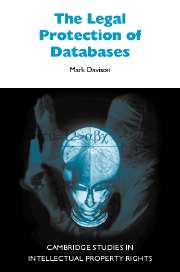Book contents
- Frontmatter
- Contents
- Foreword by William R. Cornish
- Acknowledgments
- Table of cases
- Table of legislation
- Table of European Union legislation
- Table of treaties, conventions, other international and regional instruments
- 1 Introduction
- 2 Some basic principles
- 3 Protection of databases in the EU
- 4 Transposition of the Directive
- 5 Protection of databases in the United States of America
- 6 International aspects of protection of databases
- 7 The appropriate model for the legal protection of databases
- Glossary
- Bibliography
- Index
3 - Protection of databases in the EU
Published online by Cambridge University Press: 30 June 2009
- Frontmatter
- Contents
- Foreword by William R. Cornish
- Acknowledgments
- Table of cases
- Table of legislation
- Table of European Union legislation
- Table of treaties, conventions, other international and regional instruments
- 1 Introduction
- 2 Some basic principles
- 3 Protection of databases in the EU
- 4 Transposition of the Directive
- 5 Protection of databases in the United States of America
- 6 International aspects of protection of databases
- 7 The appropriate model for the legal protection of databases
- Glossary
- Bibliography
- Index
Summary
This chapter examines the history of the Directive and its final form. It provides an overview of the official process leading up to the adoption of the Directive, and emphasises its changes in direction from the first EU documentation suggesting separate protection for databases through to the final version. In so doing, it demonstrates the myriad of potential models for sui generis protection. The initial proposals were firmly based on unfair competition principles, while the final version of the Directive draws very heavily upon copyright principles. The chapter also undertakes an analysis of individual provisions of the Directive and examines some of the difficulties associated with their interpretation. Particular emphasis is placed upon the relationship between copyright in the structure of databases and the individual contents of databases on the one hand, and the new sui generis right provided by the Directive on the other. In the course of this analysis, reference is also made to the justifications provided by various organs of the EU for the Directive's approach to particular issues and the various provisions implementing that approach. Finally, the last section of this chapter discusses the provisions of the recently adopted EU Directive 2001/29/EC of 22 May 2001 on the harmonisation of certain aspects of copyright and related rights in the information society (“the Copyright Directive”). The Copyright Directive contains provisions concerning the prohibition of circumvention of technological protection devices designed to protect copyright material.
- Type
- Chapter
- Information
- The Legal Protection of Databases , pp. 50 - 102Publisher: Cambridge University PressPrint publication year: 2003
- 2
- Cited by



